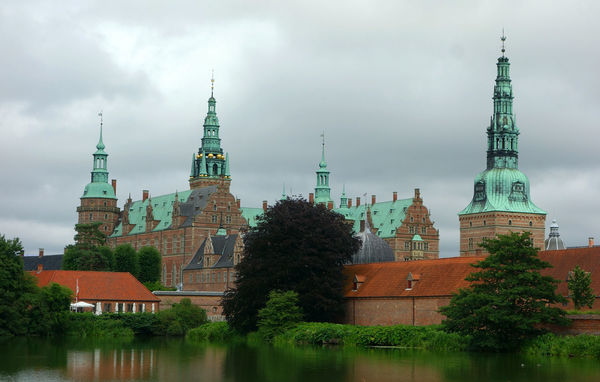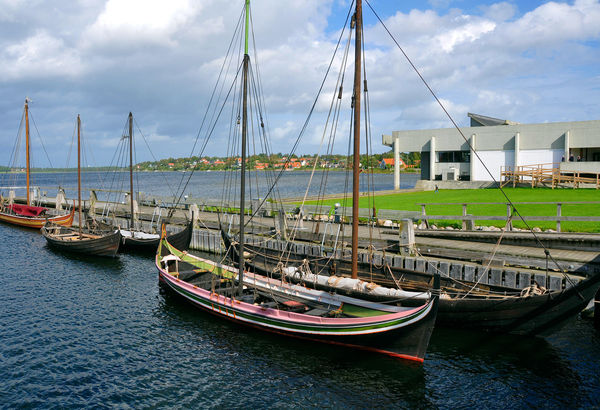Cathedrals, Vikings, and Castles: A Perfect Day Trip from Copenhagen
By Rick Steves

While I love urban thrills, it's worthwhile to get outside the city limits. Venturing 30 to 60 minutes from most European cities rewards you with great sights (Versailles near Paris), unique settings (Andechs Monastery near Munich), and small towns where you can feel the pulse of a place and its people (Haarlem near Amsterdam).
In Copenhagen, my favorite day trip is easy, convenient, and hits a trio of sights that are different from anything you'll see in Denmark's capital: an imposing 12th-century cathedral, a collection of Viking ships, and a castle floating on an island. This "Zealand Blitz" — a packed day linked by public transportation — gives travelers the highlights of Zealand (the island on which Copenhagen resides).
The first stop is Roskilde, 30 minutes west of Copenhagen. This pleasant town was the seat of the bishop and the residence of Danish royalty until 1450. In its day, it was the second biggest city in the country. Today it's famous for hosting northern Europe's largest music festival.
Hopping on the train by 8 am puts me in Roskilde at 8:30 am, and allows me to be at the cathedral when it opens at 9 am.
Roskilde's cathedral is Denmark's Westminster Abbey. It houses the tombs of 39 Danish kings and queens in a modern-looking church with great marble work, paintings, wood carvings, and an engaged congregation that makes the place feel very alive — particularly in largely unchurched Scandinavia.
Completed in 1280, Roskilde Cathedral was cleared of its side chapels and altars by the Reformation iconoclasts — leaving a blank slate for Danish royals to fill with their tombs. The highlight is strolling through a half-millennium of royal chapels, representing a range of architectural styles, from the rather austere tomb of Christian IV (ironically, one of Denmark's least austere monarchs), to the grand Neoclassical tomb of Frederik V (with mourning maidens in ancient Greek gowns), to the brick chapel outside housing the remains of Denmark's last king, Frederik IX, an avid sailor who requested to be buried with a view of the harbor. Each king or queen commissioned a tomb that suited his or her time — so different, yet all so grand.
The next stop on the blitz is the Viking Ship Museum, a 10-minute stroll from the cathedral. "Vík" literally means "shallow inlet," and "vík-ings" were the people who lived along those inlets. Roskilde — and this museum — now sit along one of these inlets.
Centuries before Europe's Age of Exploration, Viking sailors navigated their sleek, sturdy ships as far away as the Mediterranean, the Black Sea, and the Americas. This museum displays five different Viking ships, all sunk a thousand years ago (on purpose, to block an easy channel into this harbor), then excavated in modern times. The vessels represent an impressive range of shipbuilding technology, from a big, sail-powered ocean-going trade ship (like the one Leif Eriksson sailed to North America), to a 100-foot-long, 60-oar longship, to a fishing boat used for hunting whales and seals.
The museum also has replica Viking ships bobbing in the harbor, a boatyard where modern craftsmen re-create millennium-old ships using original methods and materials, and traditional craft shops like a basket maker and wood carver, sometimes staffed by workers doing demonstrations.
The final stop for the day is Frederiksborg Castle, which sits like a fairy tale on an island in the middle of a lake, 50 minutes north of Copenhagen. To get there from Roskilde, I hop a 1 pm train back to Copenhagen (buying a picnic lunch at Roskilde station and munching it onboard). Back in Copenhagen, I jump on the next train to the cute town of Hillerød and from there, a bus to Frederiksborg Castle.
The grandest castle in Scandinavia, Frederiksborg is often called the "Danish Versailles." Built in the early 1600s, Frederiksborg was the castle of King Christian IV. From the entrance of the castle complex, it's an appropriately regal approach to the king's residence. I can almost hear the clopping of royal hooves on the cobbled lane as I walk over the moat.
Inside is the grandest royal chapel in Europe. For 200 years the coronation place of Danish kings, the chapel is still used for royal weddings. The castle also houses an exhaustive but fascinating museum collection spanning three floors. The museum juxtaposes portraits, paintings of historical events, furniture, and other objects, including the first Bible translated into Danish and a golden globe illustrating Copernicus' bold new theory — that the sun, not the earth, was the center of our world.
After exploring five centuries of Danish history at the castle, I'm ready to return to modern times. I hop on a 6 pm train and am back in Copenhagen by dinnertime, having seen the highlights of Zealand in one busy but thrilling day.

